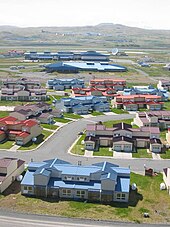Adak Island
| Adak Island | ||
|---|---|---|
| Mount Adagdak | ||
| Waters | Pacific Ocean | |
| Archipelago | Aleutian Islands | |
| Geographical location | 51 ° 53 ′ N , 176 ° 39 ′ W | |
|
|
||
| length | 48 km | |
| width | 32 km | |
| surface | 725 km² | |
| Highest elevation |
Mount Moffett 1189 m |
|
| Residents | 316 (2000) <1 inh / km² |
|
| main place | Adak | |
| Adak Island | ||
Adak Iceland is an island of the archipelago Andreanof Islands within the island chain of the Aleutian Islands in Alaska . It is located between the islands council Islands in the West and Fox Islands in the East.
Adak Island is 14 km east of Kanaga Island, from which it is separated by the Adak Strait , and about 1 km west of Kagalaska Island . The island is 48 km long and up to 32 km wide. The highest point is the 1,189 m high volcano Mount Moffett , which together with the volcanoes Mount Adagdak and Andrew Bay represents a small common volcanic center (~ 40 km³), which forms the northern peninsula of Adak Island. Other mountains worth mentioning are Mount Reed and Mount Vincennes . The mountainous island with few flat areas and hundreds of small lakes has an ice-free port and Adak Airport is the most modern airport in the Aleutian Islands. On the island is Adak , the southernmost city of Alaska.
Adak means in the Unangan language in its original spelling Adaq father .
Alaska Airlines connects Adak Island with King Salmon and Anchorage .
history
Adak Island has been inhabited by the Unangan since ancient times . Russian explorers visited the island in the 18th century, but they did not establish permanent settlements. During World War II , the Japanese Army occupied two of the westernmost Aleutian Islands - Attu and Kiska . In return, the American forces began a campaign to drive out the Japanese occupiers. With the closest US presence in Cold Bay , the military began building bases in the western Aleutian Islands from which to conduct operations against the Japanese. Adak Island was selected as the airfield and bombing of the two occupied islands began in September 1942. Attacks against the Japanese, including major army ground operations, began in May 1943 with an American landing on Attu. The reconquest took the lives of approximately 2,500 Japanese and 550 Americans. Landing on Kiska was trouble-free because the Japanese had abandoned the island, sheltered under the cover of the fog, and left an empty island for the Americans.
In the further course of the war, the island was used for radio reconnaissance , as Adak Island was the closest US terrain to the Japanese military facilities on the Kuril Islands . Adak Naval Air Station remained a military base during the Cold War, but was then reduced in 1995 and closed in March 1997.
Shortly thereafter, the city of Adak was founded on the site of the previous base. After a maximum population of 6,000, the island had 316 people according to the 2000 census , all in Adak, in the northern part of the island. In 1980 the Aleutian Islands National Wildlife Refuge was formed. Most of Adak Island is within the boundaries of this reserve.
Sea-based X-band radar is stationed at Adak as part of the US missile defense system .
Web links
- Aerial photo ( Memento from December 30, 2011 in the Internet Archive )
- Moffett volcano
- Pictures of Adak from a naval veteran



